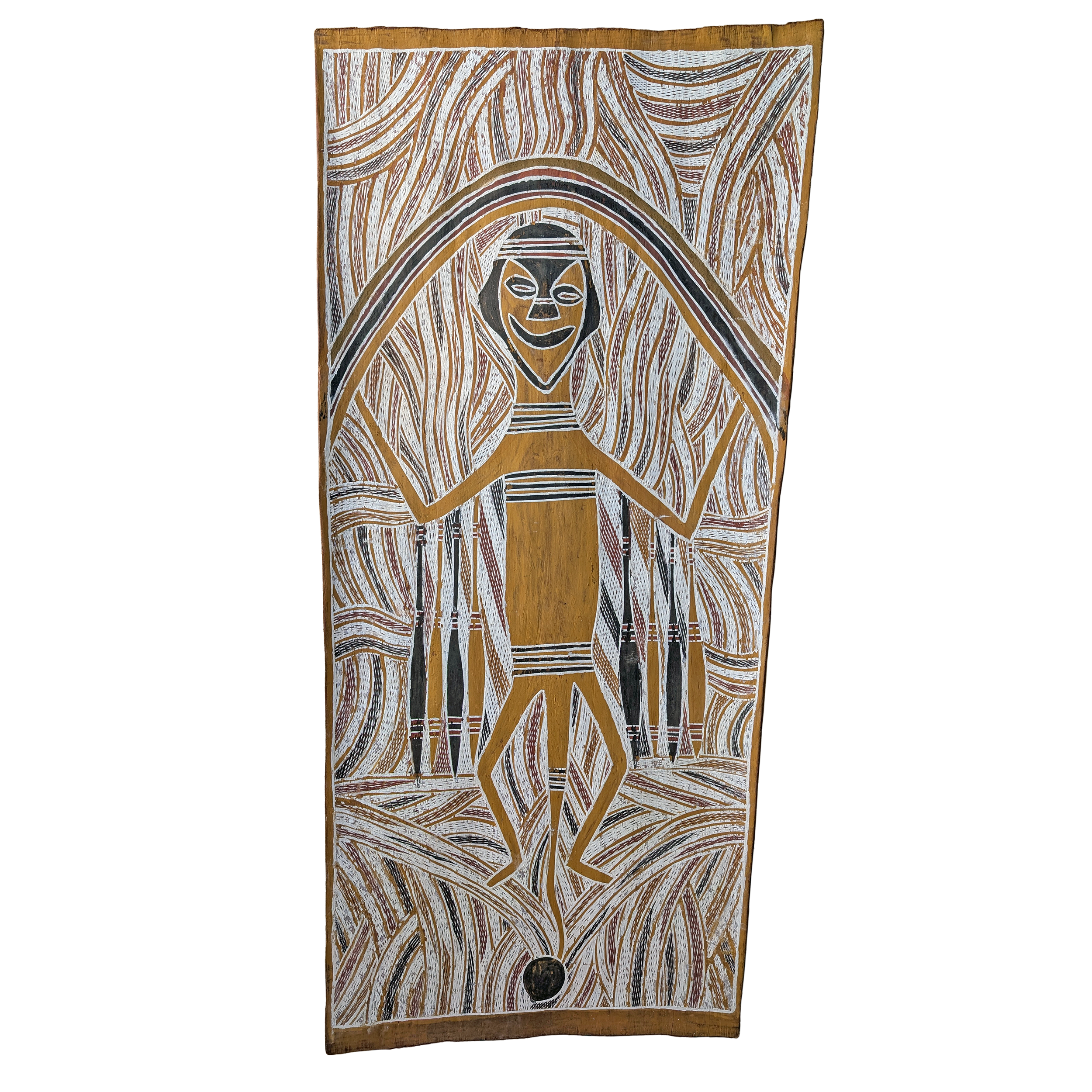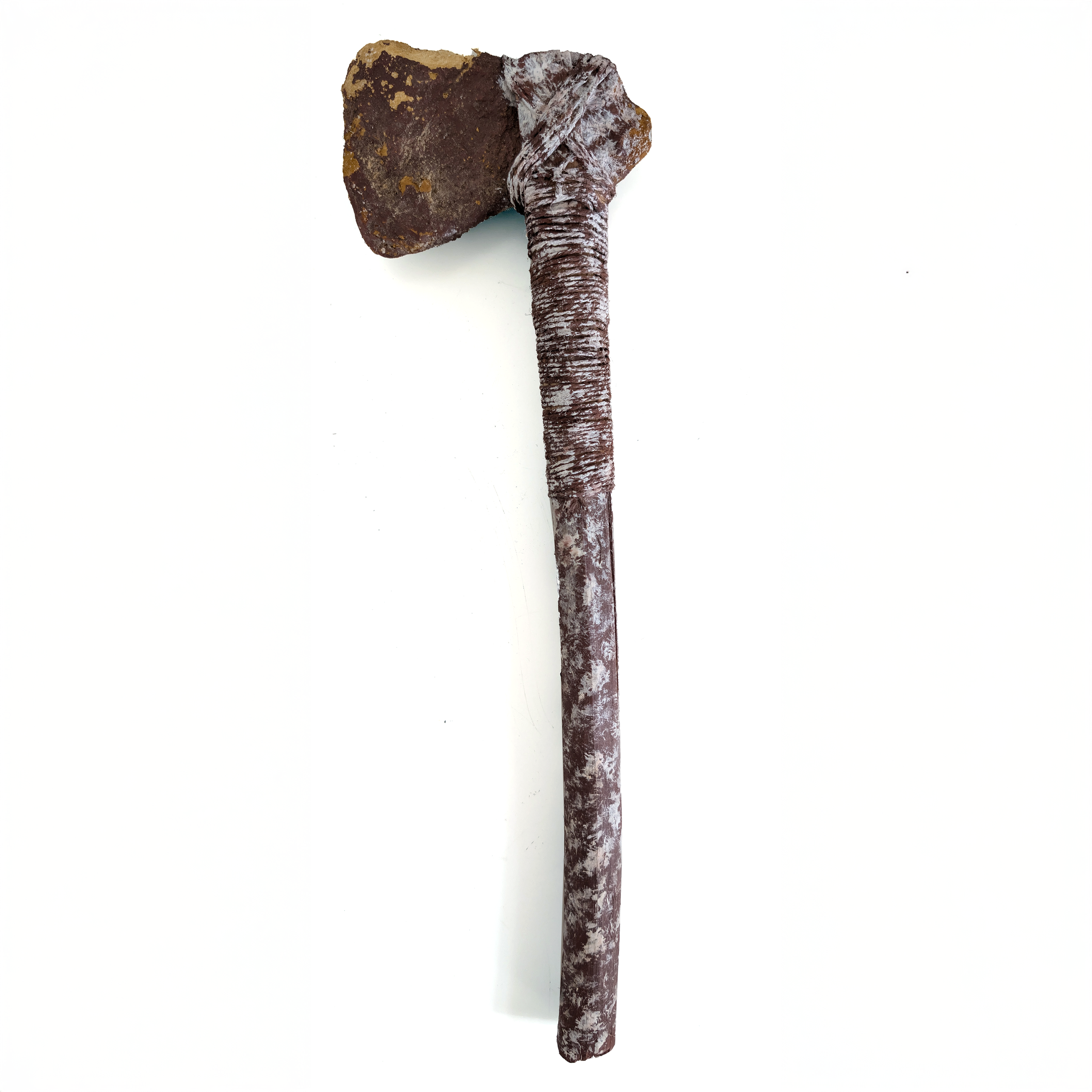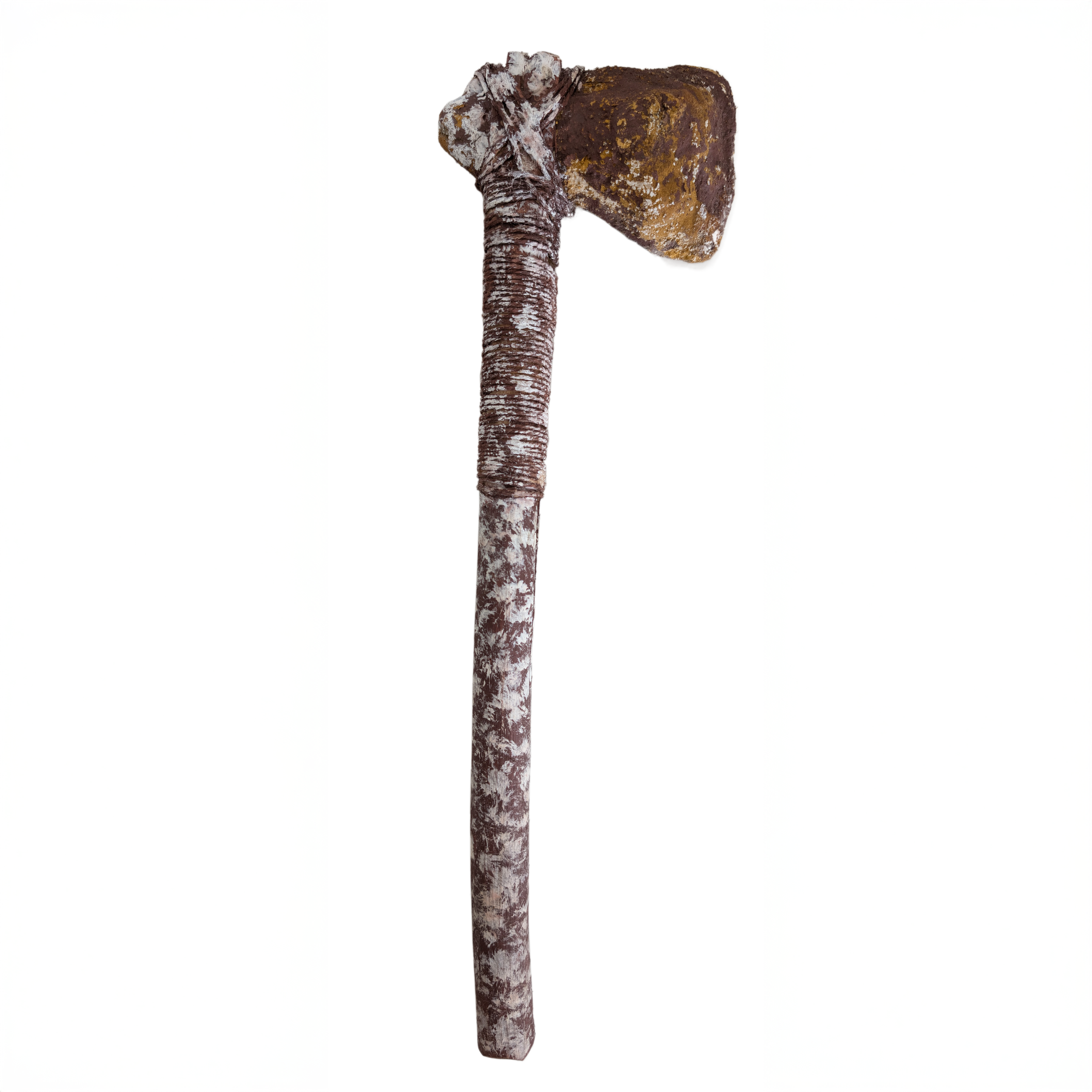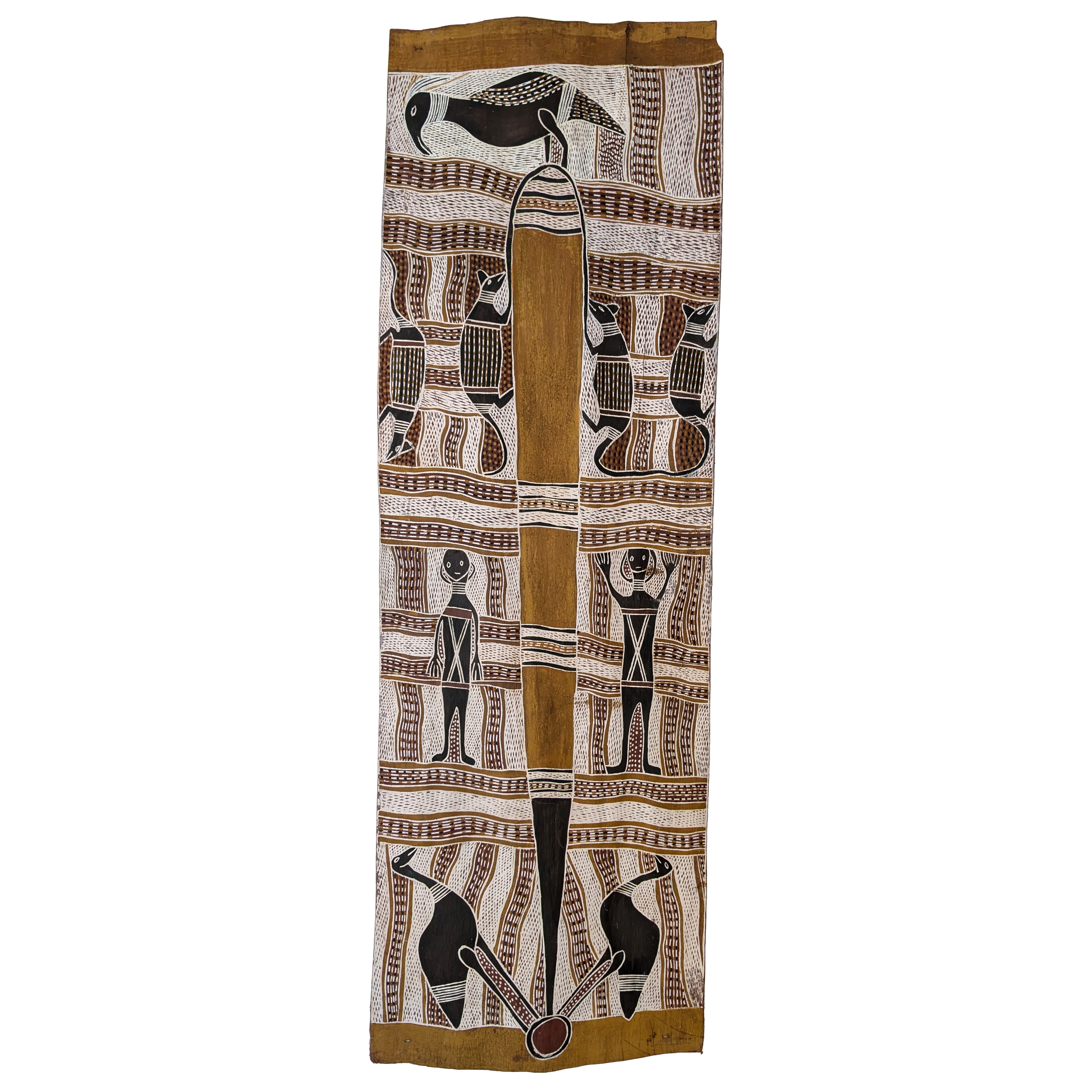
Artist: Djawida Nadjongorle | Title: Kinga (Saltwater Crocodile) | Year: 2002 | Medium: natural earth pigments on bark | Dimensions: 69 x 27.5 cm
PROVENANCE
Injaluk Arts, Oenpelli -Gunbalunya NT, Cat No. 353b-02
Cooee Art Gallery, Sydney NSW Cat No. 7699
ARTWORK STORY
Kinga, the saltwater crocodile (Crocodylus porosus) is a highly respected and feared animal, associated with many Dreaming sites in Arnhem Land. In the past it was also hunted for food. Kinga can travel in salt water or fresh water, and often travel long distances between river systems. Kinga make their nests in the long grass or forest areas close to rivers, billabongs and water holes. These are piles of mud and vegetation where they lay their eggs. They are very aggressive around their nests. Kinga are often depicted alongside their prey such as namarnkol (barramundi).
Nawu kinga nakka nabang mayh, minj karrikilekme karriborrkbun wardi kanbaye kanbun karridowen. Karriwern karrikengeme bininj dja mayh warridj dja bu korroko nahni mayh kinga birringuni dja Djang warridj ngadberre kadjangdi kore kubolkwern kunred ngadberre. Kinga nungan mayh kayawan kangun kare kore kurrula dja kare kore kubowinjku kukku. Kinga karedmarnbun kore kungarre kurralk kore kukku darnkih djengkeh kamarnbun wanjh wirllarrk kawirllarkngukdeng dja darnkih kayiyo nawu wirllarrk. Bu ngiredyikan darnkih kore wirllarrk kahyo nuye wanjh ngunbaye ngunbun.
(Text: Andrew Manakgu)
Artist Profile
COMMUNITY/REGION
Oenpelli Western Arnhem Land, NT
LANGUAGE
Kunwinjku
BIOGRAPHY
Djawida Nadjongorle was born in 1943 in the remote bushlands of Dialbangurr, his father’s country in Western Arnhem Land. His family later relocated to the nearby community of Oenpelli (now Gunbalanya), where both his parents worked in the buffalo industry as skinners and salters. Djawida attended school in Oenpelli and spent much of his childhood in the area, though his family would occasionally return to their ancestral lands. It was during these trips that Djawida developed an interest in art, beginning by replicating traditional rock paintings he encountered, focusing on depictions of animals and Mimi spirits. He also left his mark through hand and foot stencils on rock surfaces.
A self-taught artist, Djawida learned to grind ochres and apply them in painting. Over time, he transitioned from rock art to painting on bark and, later in his career, on paper. In addition to painting, he also crafted traditional tools such as spears and didgeridoos. Djawida’s art reflects stories from several ancestral lands: his father’s country at Dialbangurr, his mother’s country at Kudjekbinj (which includes the Nawurra story), and his grandmother’s land near Manmoyi.
© Adrian Newstead
PROVENANCE
Injaluk Arts, Oenpelli -Gunbalunya NT, Cat No. 353b-02
Cooee Art Gallery, Sydney NSW Cat No. 7699
ARTWORK STORY
Kinga, the saltwater crocodile (Crocodylus porosus) is a highly respected and feared animal, associated with many Dreaming sites in Arnhem Land. In the past it was also hunted for food. Kinga can travel in salt water or fresh water, and often travel long distances between river systems. Kinga make their nests in the long grass or forest areas close to rivers, billabongs and water holes. These are piles of mud and vegetation where they lay their eggs. They are very aggressive around their nests. Kinga are often depicted alongside their prey such as namarnkol (barramundi).
Nawu kinga nakka nabang mayh, minj karrikilekme karriborrkbun wardi kanbaye kanbun karridowen. Karriwern karrikengeme bininj dja mayh warridj dja bu korroko nahni mayh kinga birringuni dja Djang warridj ngadberre kadjangdi kore kubolkwern kunred ngadberre. Kinga nungan mayh kayawan kangun kare kore kurrula dja kare kore kubowinjku kukku. Kinga karedmarnbun kore kungarre kurralk kore kukku darnkih djengkeh kamarnbun wanjh wirllarrk kawirllarkngukdeng dja darnkih kayiyo nawu wirllarrk. Bu ngiredyikan darnkih kore wirllarrk kahyo nuye wanjh ngunbaye ngunbun.
(Text: Andrew Manakgu)
Artist Profile
COMMUNITY/REGION
Oenpelli Western Arnhem Land, NT
LANGUAGE
Kunwinjku
BIOGRAPHY
Djawida Nadjongorle was born in 1943 in the remote bushlands of Dialbangurr, his father’s country in Western Arnhem Land. His family later relocated to the nearby community of Oenpelli (now Gunbalanya), where both his parents worked in the buffalo industry as skinners and salters. Djawida attended school in Oenpelli and spent much of his childhood in the area, though his family would occasionally return to their ancestral lands. It was during these trips that Djawida developed an interest in art, beginning by replicating traditional rock paintings he encountered, focusing on depictions of animals and Mimi spirits. He also left his mark through hand and foot stencils on rock surfaces.
A self-taught artist, Djawida learned to grind ochres and apply them in painting. Over time, he transitioned from rock art to painting on bark and, later in his career, on paper. In addition to painting, he also crafted traditional tools such as spears and didgeridoos. Djawida’s art reflects stories from several ancestral lands: his father’s country at Dialbangurr, his mother’s country at Kudjekbinj (which includes the Nawurra story), and his grandmother’s land near Manmoyi.
© Adrian Newstead







